Tag Archive: implementation ideas
April 9, 2015
by Carole Zangari -
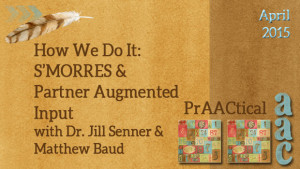
Mnemonics are such a great memory aid, so when Dr. Jill Senner and Matthew Baud offered to share the visual support that they use in their clinical work, I knew it would be of interest to many of you. Combine that with content on partner training, and we have a real treat for you: S’MORRES. Dr. Senner is the owner of Technology and Language Center where she specializes in providing AAC and AT services including assessment, consultation and training, and workshops/lectures. She has presented at numerous national AT conferences and has taught graduate courses in AAC and swallowing disorders. Matthew Baud is the Assistive Technology Coordinator at Niles Township District for Special Education, performing evaluations, trainings and coaching communication partners. Matthew also has his own AAC private practice, and is an adjunct professor at Saint Xavier University where he teaches a graduate course in AAC. In this post, they share S’MoRRES, a strategy for building... [Read More...]
Filed under: PrAACtical Thinking
Tagged With: aided language input, implementation ideas, Jill Senner, Matt Baud, partner strategies, partner training
March 30, 2015
by Carole Zangari -
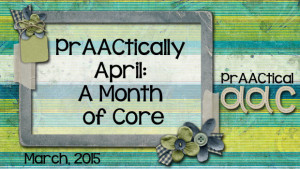
April is right around the corner, making this the perfect time to prepare some materials for practicing a new set of core vocabulary words. Rachael Langley is back to share some fun ideas for easy things to do to put that core vocabulary to work. She’s made two calendars, one with a focus word for each week and another one that covers many of the words in the April Year of Core Vocabulary list. These are great tools to print and share with classrooms or families. Click on the image to download the calendars or visit the Downloads sections of the eToolBox. Thanks for these great resources, Rachael!! Rachael has been working in the public schools as a speech-language pathologist for over 12 years. Currently working as an AAC Specialist in Mid-Michigan, Rachael tells us that she strives to spread the message about the importance of AAC and unlocking the communication... [Read More...]
Filed under: PrAACtical Thinking
Tagged With: Calendar, core vocabulary, implementation ideas, Rachael Langley
March 23, 2015
by Carole Zangari -
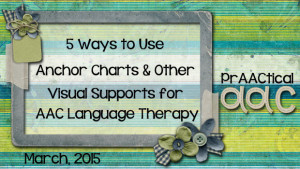
Anchor charts are a visual way to outline, describe, or illustrate a procedure, strategy, or concept. They are widely used visual supports in general education classrooms across the grade levels. In AAC therapy, anchor charts offer several benefits. First, making the anchor chart forces us to distill the main ideas in whatever it is we are teaching. What are the key aspects of what we are teaching? We have to answer that to create our anchor chart, and that gets us really thinking about the concept/process/strategy in great detail. Selecting the critical elements for our anchor chart helps us focus on the constructs that are most important to teach. Secondly, it helps us explain the concept/process/strategy in a more concise and articulate way. Putting things into writing forces us to clarify our explanations, and allows us to carefully consider what to say and how to say it. Yes, we sometimes... [Read More...]
Filed under: PrAACtical Thinking
Tagged With: AAC intervention, anchor charts, implementation ideas, visual supports
December 19, 2014
by Carole Zangari -

Whether it is electronically or by postal mail, many of our prAACtical friends are sending and receiving holiday greetings this week. Here are some thoughts on taking advantage of their novelty and using them to build language and literacy skills. Core Vocabulary: Lots of opportunity to practice using core words. Can I have it? I like it. It is fun. Give it to me. Do you want it? I want to see. We can do it (together). I can see it. Do you want to do more? Can you see the ___? WH Questions: Make it a game to pick a card to talk about. Everyone can have a turn asking and answering questions like these and get some core word practice in at the same time. Who gave it? Where are they? What do you think? Why do you like (not like) it? Stop and Go: Have a cute... [Read More...]
Filed under: PrAACtical Thinking
Tagged With: holiday, implementation ideas
December 4, 2012
by Carole Zangari -
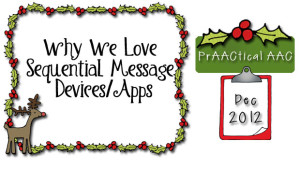
Earlier this fall, I spoke with an SLP who was beginning to serve a new classroom of students with significant disabilities, including many kids with AAC needs. Jenna had been into the classroom a few times to meet the teacher and the kids, and get a sense of the daily schedule, curriculum, and materials. She was (rightfully) concerned about how few AAC materials were available and we strategized a little bit about a long-range plan to address that. In the short term, though, we decided to focus on what they DID have in that classroom. Among the treasures, a sequential message communication device. What Are Sequential Message Communication Devices? These are simple devices that let you record messages in segments and then replay them in that same order. The initial activation of the device speaks the first part of the message aloud and then stops. When you activate the device... [Read More...]
Filed under: PrAACtical Thinking
Tagged With: implementation ideas, sequential message device, SGD
November 20, 2012
by Carole Zangari -
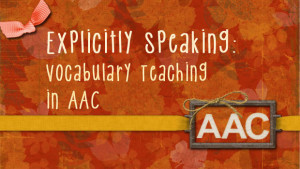
An essential part of the model we shared for AAC semantic intervention is Step 2, teaching the new words with explicit instruction activities. In our posts, explicit instruction refers to the process of designing and using carefully planned sequence of empirically-supported teaching activities. Though focused on reading, not vocabulary, development, this PowerPoint presentation by Dr. Anita Archer gives an excellent overview of the characteristics of explicit instruction. In our initial teaching of new words, we to be sure that the learners have frequent opportunities to respond: Active participation is critical at this point. We have to give the learner a lot of opportunities to say the word (e.g.,“resume”) and tell about it (e.g., “keep going,” “start again and not stop,” “verb”, etc.). We want to elicit a lot of responses so that we can monitor their performance. That allows us to provide feedback that is affirmative when the learners respond... [Read More...]
Filed under: PrAACtical Thinking
Tagged With: implementation ideas, new word learning, semantics, teaching, teaching activities, vocabulary
October 19, 2012
by Carole Zangari -
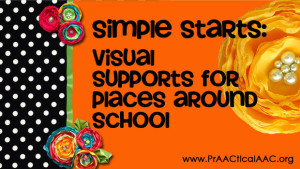
Simple Start is a series of posts that discuss AAC-related tools and strategies that are rather quick and easy to make or implement. Whether you are brand new to AAC or relatively experienced, we all come to a point where complicated just won’t do. – In our first Simple Start, we’re talking about Picture Card Rings, a type of visual support for language comprehension. The National Professional Development Center on Autism Spectrum Disorders defines visual supports as any tool presented visually that can help a person function in their day-to-day life. In this case, we’ve narrowed it down to the specific case of using photos of places around a school to help the student better understand words like ‘cafeteria’ and ‘clinic.’ — Most people with AAC needs do not require a communication system that represents language through photographs. This is a very good thing since there is no way to... [Read More...]
Filed under: PrAACtical Thinking
Tagged With: implementation ideas, photograph, PowerPoint, resources, Simple Start, visual support
October 13, 2012
by Carole Zangari -
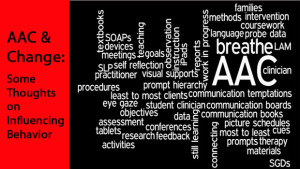
As SLPs who do the work of AAC, we all play many roles. We’re therapists and educators. We counsel and coach. We make materials, troubleshoot technology, take data, and write documentation. We advocate for the individual, institution, and society. A common thread that runs through many of these roles is this: Very often, we want people to change their behavior. We may want them to implement a strategy, use different materials, provide more services, agree to a decision, fund a communication device, learn more about what they’re doing, or something else. But we are trying to influence others to change. It is taking us (Robin and Carole) a lifetime to figure out how best to do this. Like you, we face it practically everyday. Each week, we cross paths with a few people who have bad information about AAC, or not enough information, negative attitudes, indifference, or apathy. We try... [Read More...]
Filed under: PrAACtical Thinking
Tagged With: change, implementation ideas, influence, teams
October 8, 2012
by Carole Zangari -
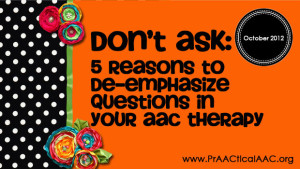
Questions are more like assessment than they are like instruction. Don’t believe us? Look at the questions these therapists posed and see if you didn’t feel like you were being quizzed. What’s your name? Where do you live? Do you know your address? How old are you? When’s your birthday? What school do you go to? What’s your teacher’s name? What’s that called? What do we do with that? Can you tell me more about it? Just to be clear, we think data-based decision-making always plays an important role in good therapy. However, assessment is assessment. Assessment helps us figure out what to teach and how to teach it. But it should look and sound very different than instruction. So when the SLP tells us she is going to teach a new skill by asking a question, we start to tense up. Here’s why we’re de-emphasizing questions in our AAC... [Read More...]
Filed under: PrAACtical Thinking
Tagged With: implementation ideas, intervention, language facilitation
October 7, 2012
by Carole Zangari -
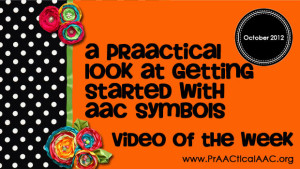
For this week’s video, we head back to the Aaron W. Perlman Center at Cincinnati Children’s Hospital Medical Center for a wonderful video about getting started with AAC symbols. We know you will enjoy this overview of some of the most popular AAC symbols and the lovely examples they share. –
Filed under: Video of the Week
Tagged With: AAC system, choice making, getting started, implementation ideas, intervention, symbol









